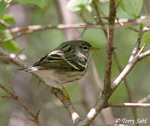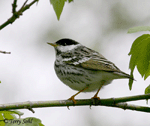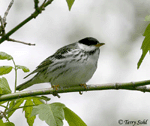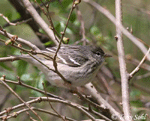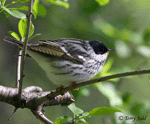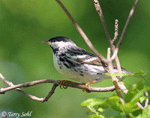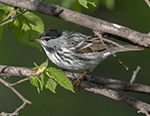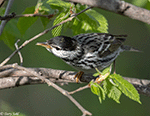Blackpoll Warbler
Setophaga striata
| Length: 5.25 inches | Wingspan: 8.5 inches | Seasonality: Migrant |
| ID Keys: Black cap, white cheeks, white underparts with black side streaks, 2 white wing-bars | ||
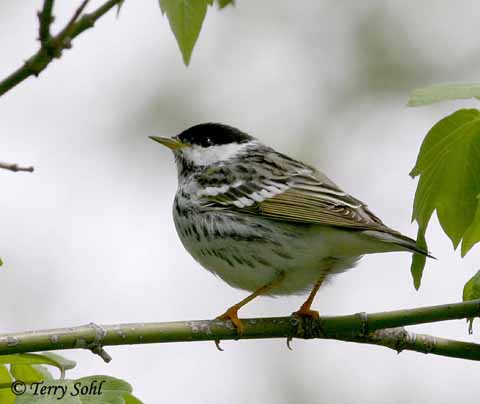 Blackpoll
Warblers are a champion migrant, often going non-stop from the Northeastern
coast of the U.S. to northern South America every fall. It's been estimated
that the non-stop flight may take individual birds up to 3 days to
complete. Blackpoll Warblers are usually fairly common in Spring migration
through South Dakota, but are much less common during the fall.
Blackpoll
Warblers are a champion migrant, often going non-stop from the Northeastern
coast of the U.S. to northern South America every fall. It's been estimated
that the non-stop flight may take individual birds up to 3 days to
complete. Blackpoll Warblers are usually fairly common in Spring migration
through South Dakota, but are much less common during the fall.
Habitat:
Deciduous woodlands, parks, gardens in migration. Stays in conifer forests and thickets on breeding grounds in Canada and Alaska.
Diet:
Mostly insects and berries, including aphids, beetles, mosquitoes, ants, termites, and spiders. Will also eat seeds on occasion.
Behavior:
Moves deliberately along foliage and branches of trees and shrubs, gleaning insects from the vegetation as it goes. Also is capable of flycatching, flying out from a perch and capturing insects in mid-air.
Nesting:
A non-breeder in South Dakota. On their breeding grounds in Canada and Alaska, the nest of a Blackpoll Warblers is constructed by the female, placed near the trunk of a small evergreen tree, usually from 1 to 20 feet from the ground. The nest is built of sticks and grasses, sometimes lined with lichen, feathers, or moss. The female lays 3 to 5 eggs, and she alone incubates them. The young hatch after about 12 days.
Interactive eBird Map:
Click to access an interactive eBird map of Blackpoll Warbler sightings
Song:
The song of a Blackpoll Warbler is a short series of notes, quiet at first, rising in volume, and then fading again at the end. Both males and females also have a sharp chip note call.
1Click here to hear the song of a Blackpoll Warbler
2Click here to hear the call notes of a Blackpoll Warbler
Migration:
Summers in central to northern Canada, winters northern South America. In South Dakota, Blackpoll Warblers are much more common as a spring migrant than they are as a fall migrant.
Similar Species:
If seen well, male Blackpoll Warblers do have a distinctive plumage pattern. Females may be more difficult to identify. Species most likely to be confused with a Blackpoll Warbler include the following:
- Black-and-White Warbler - Black-and-White Warblers are common migrants in South Dakota, with much smaller numbers staying to breed during the summer months (primarily in the far western part of the state). Both species may be present together at the same time during migration, and could pose an identification challenge. Male Black-and-White Warblers have a striped crown a black cheek, while male Blackpoll Warblers have a completely black crown and a white cheek. Note behavior also separates the species, as Black-and-White Warblers typically forage by clinging to the trunk or branches of a tree and clambering over it "nuthatch style" as they feed.
- Black-throated Gray Warbler - Just a very rare visitor to South Dakota, they could potentially overlap with Blackpoll Warblers on the rare instances where they are found in the state. Black-throated Gray Warblers have a black crown like a Blackpoll Warbler, but have a more complex facial pattern, with a white stripe above the eye, black through the eye and upper check, and white stripe on the lower cheek, and a black throat. Black-throated Gray Warblers also have a yellow spot in front of the eye.
- Cape May Warbler (Female) - Females of both species may be similar, but Cape May Warblers are typically more brightly colored, with stronger yellow tones than a female Blackpoll Warbler. Cape May Warblers typically have one white wingbar while Blackpoll Warblers have two.
- Blackburnian Warbler (Female) - Both species share the pair of bold white wing bars, and some faint streaking on the flanks. Blackburnian Warbler females, however, tend to have an pale orangish hue on the breast, throat, and head, while female Blackpoll Warblers are plainer or have a faint yellowish wash.
Conservation Status:
Blackpoll Warblers are still found over a very broad geographic range, and are common in parts of that range. However, surveys in recent decades have shown substantial declines in overall populations. Reasons for the decline are not clearly understood, but likely includes a combination of both habitat loss and climate change. As a result of the recent declines in populations, as of 2018 the IUCN cautiously listed the Blackpoll Warbler as a "Near Threatened" species.
Further Information:
1) BirdWeb - Blackpoll Warbler
2) WhatBird - Blackpoll Warbler
3) Audubon Guide - Blackpoll Warbler
Photo Information:
May 13, 2005 -- Minnehaha County -- Terry L. Sohl
Additional Photos:
Click on the image chips or text links below for additional, higher-resolution Blackpoll Warbler photos.
Audio File Credits:
1Aiden Place. Recorded in Rutland County, Vermont on July 9th, 2019. Original recording and information from xeno-canto.
2Lucas Berrigan. Recorded in Yarmouth County, Nova Scotia on June 5th, 2016. Original recording and information from xeno-canto.
| Click on the map below for a higher-resolution view |
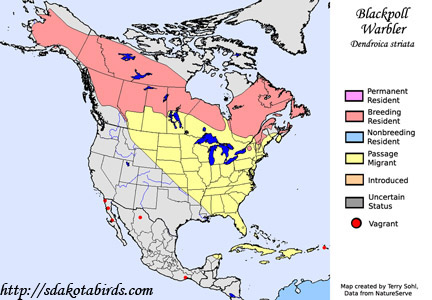 |
| South Dakota Status: Common spring migrant in the eastern part of the state, rare in the west. Much less common fall migrant. |
Additional Blackpoll Warbler Photos
Click for a higher-resolution version of these photos
